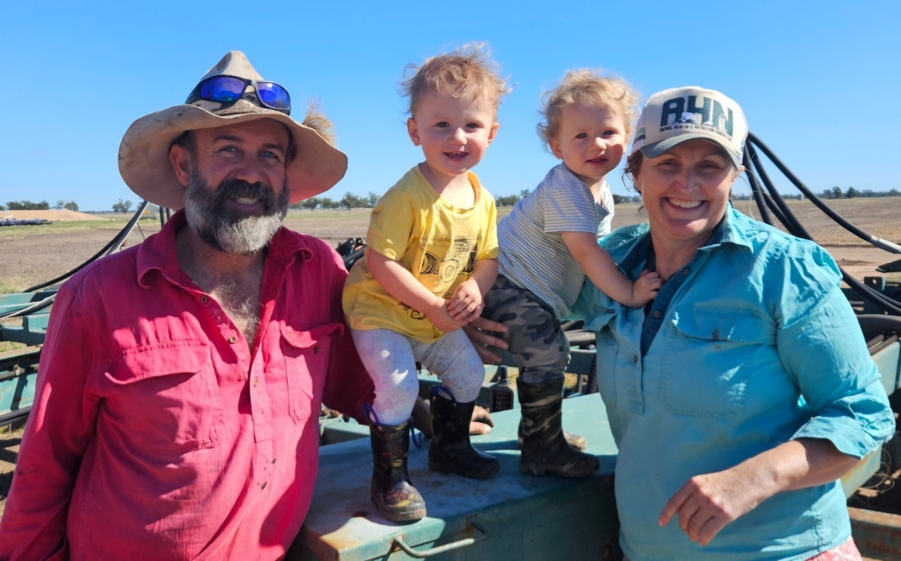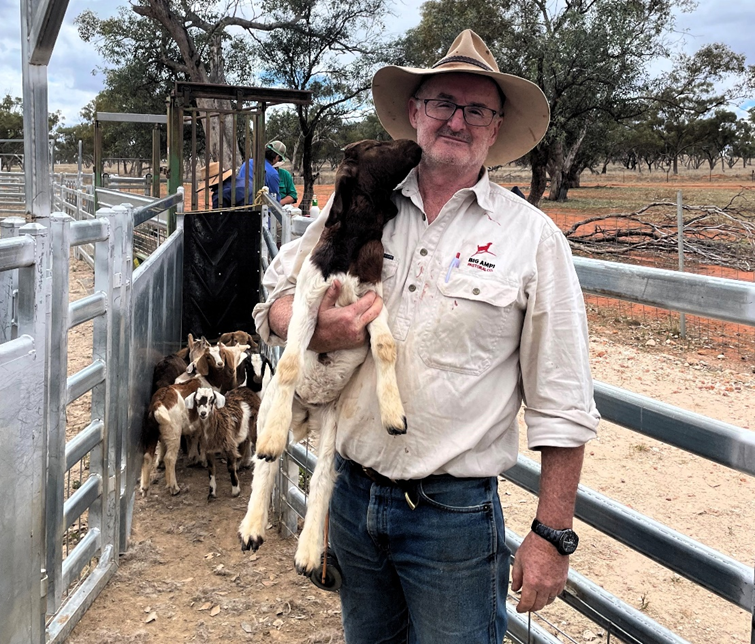New GIRDAC members appointed
21 June 2024
Key points:
- NSW goat producers, James Nalder, Cudgewa, Coonamble and James Boland, Mount Hope Pastoral, Mount Hope, have been appointed to GIRDAC.
- Both producers run fully managed goat enterprises and use eID tags to collect data on their goats.
- GIRDAC is an advisory group which provides recommendations on goat levy investment in research and development (R&D) and extension and adoption (E&A) initiatives for the Australian goatmeat industry.
NSW goat producers, James Nalder and James Boland have been appointed to the Goat Industry Research, Development and Adoption Committee (GIRDAC).
GIRDAC is an advisory group which provides recommendations on where goat levy funds are invested in research and development (R&D) and extension and adoption (E&A) initiatives for the Australian goatmeat and livestock industry.
Here, James N and James B discuss their goat operations and how they believe the Australian goatmeat industry can evolve.
James and Emma Nalder and their children.
James Nalder, Cudgewa, Coonamble NSW
James and Emma Nalder, Cudgewa, Coonamble, are focused on making goats an integral part of their mixed farming enterprise which includes Angus cattle and broadacre cropping.
Following the 2017–19 drought, and with low cattle numbers on hand and high cost to restock more cattle numbers, the Nalders made the decision to run goats commercially as an alternative enterprise.
The Nalders have been steadfastly involved in the industry since then and now run a fully managed goat enterprise.
James said they are focused on improving their composite herd, which comprises Boer-cross, harvest rangeland and Contender meat goat genetics.
“Our numbers have fluctuated with the markets and we’re currently running 700 does, down from 1,200, but with a plan to increase to 2,500 once more fencing is done and we can see a price signal that prices will improve,” James said. “We have been using eID tags since we became involved in the Kids+ R&D project and we’re now into the second year of that five-year project.
“We’re starting to use the data the project is collecting to inform our management decisions and make gains based less on subjective measures and more on objective metrics, to produce a better meat goat.
“We’re focused on selecting the right animals going ahead, and even more critically, not selecting the wrong animals.
“From a management point of view, it’s easier working with goats than sheep. The browsing ability of the goats also means they are able to utilise some of our scrubbier paddocks more effectively than cattle, and certainly sheep have in the past.
"We have run cattle and goats together in the same paddocks, except during kidding, without any negative effect on either enterprise.”
The Nalders have been turning off their goats in the 30–34kg weight range to meet current market demand, supplying both export and domestic markets.
Looking ahead, James said focusing on improving enterprise profitability and goat quality would be beneficial to seeing the industry going ahead.
“The domestic goat market would be great to expand but it’s quite limited at this point because there’s such a lack of availability and there is probably also a risk of flooding the market,” James said.
“There’s demand there but it’s an unknown quantity in terms of how big of a market there is.”

James Boland, Mount Hope Pastoral.
James Boland, Mount Hope Pastoral, NSW
James Boland is one of the team at Mount Hope Pastoral, running a large-scale managed goat operation at Mount Hope in the Western Division of NSW.
Over the past 12 years, the business has transitioned and expanded from a wild harvested rangeland goat operation to a fully managed system.
The owners have undertaken significant investments in infrastructure including fencing, yards, and water, to transform part of the aggregation from running Merino sheep to goats.
The business runs Boer composite does in a fully managed production system and F1 does running with Boer and Kalahari bucks in a semi-managed system.
Does in the managed system are joined three times over a 24-month period and eID tags are used to collect data on traits including fertility, fecundity and productivity.
James said there is an enormous opportunity for the industry to harness and promote the benefits of goatmeat produced through managed and semi-managed systems, particularly in the domestic market.
“We think what managed systems bring to the marketplace is continuity of supply and consistency of product, produced in a sustainable and ethical way,” James said.
“In a managed system, we can produce a carcase with a desired amount of muscling, weight and fat cover, and hopefully with high yield.
“At the moment, those attributes of continuity of supply and consistency of carcase don’t translate into a margin for us at the farm gate, which makes funding the capital expenditure and operational expenditure associated with a managed system a challenge.
“We are interested in how we can create new market opportunities based on the great nutritional attributes of goatmeat, with certainty that it will always be on the shelf and always presenting the same way.
“We would love to work up and down the supply chain to normalise goat consumption, for it to be just another protein source available to domestic consumers, regardless of demographic, and embracing preparation techniques that aren’t necessarily slow cooking. We think the managed segment of the goat industry in Australia is going to be key to doing that.
“The goat industry is built on export opportunity and now there’s a segment of industry which is vitally interested in championing a robust a domestic opportunity.”
James said the experience of the 2018–2019 drought, which saw the business retain 4,000 core breeding does, demonstrated the environmental benefits of running goats in a managed system.
“Our spatial analysis of groundcover and green cover showed that when the drought broke, the country on which we’d been running those managed goats, bounced back much quicker than district properties that were running different species and had largely been destocked,” James said.
“Goats tend to tolerate dry seasons because they’ll graze around 70% and browse 30%, whereas other species predominantly graze.
“Our country responded really quickly when the drought broke in 2020. We think, in our region, there is absolutely a place for sustainable and ethical production of goatmeat in a managed system.”
The business has run a range of on-farm R&D trials over the years, examining topics such as the use of pain relief when castrating males, the impact of supplementary feeding on a range of measurements, and factors impacting kid survival rates.
The next on-farm trial to be undertaken this year will see the group work with a celebrity chef on desired carcase attributes and eating quality of females, castrated males and entire males from the same drop. As much as possible they will be processed at the same weight and body condition score.
“They will all be a similar carcase size, with similar muscling and fat cover and have different cuts cooked identically to see if there is any subjective difference in the eating quality,” James said.
“We’re also interested in the objective measure of the effect of wethering on weight gain and any potential onset threshold for taint associated with the entire males.”


